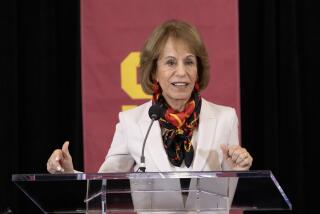Budget, Burnout Pushed Top Architect at CSU San Marcos to Quit
- Share via
Six weeks ago, Al Amado stood amid the new Cal State San Marcos campus, smiling because he had triumphed over early construction problems that had most people predicting there would be a six-month delay in the opening.
Amado, the assistant vice president for physical planning and campus construction, was also smiling then because, as an architect, he had the best job he could imagine: to design and build a university from scratch.
But Wednesday, Amado resigned, weary of begging for every dollar from Sacramento to build the campus, and the political infighting among university faculty and administration.
Amado, 42, is the second high-ranking California State University, San Marcos official to leave the fledgling university. Two months ago, Executive Vice President Richard R. Rush resigned to become president of Mankato State University in Minnesota.
“A lot of things have happened and it’s been over a period of time,” Amado said Friday. “A lot of heavy-duty politicking and the financial stresses of the state and not being able to move forward like we would like to.”
Amado said the stress of strict deadlines, the constant pleading to the California State University system and the state for money to build the campus, as well as the state’s budget crisis, combined to make the job unbearable.
The university was criticized by other campuses in the system for certain aspects of its new buildings that some considered extravagant, including using natural stone instead of stucco for the exterior of two walls of Craven Hall, the main administration building, Amado said.
“I have a philosophy that we are building edifices that will be here after we are all gone,” Amado said. “It’s important that we take a posture as a society of understanding that this architecture make a statement of who we were back in 1990.”
“A lot of people (outside Cal State San Marcos) see our project as strictly utilitarian,” Amado said.
“We have other campuses (in the state) that are in desperate need of funding and are, frankly, not pleased to see that the new campus is being funded,” he said. “It’s horrible political pressure because of the financial status we’re in.”
While Amado said he still believes that developing a university campus from scratch is an ideal job for an architect, in the end, he said, it wasn’t worth it.
Amado praised university President Bill Stacy as “a very fine person to work for. . . . He was very much a mentor.”
Amado declined to name specific people at the university with whom he had clashed. But having to share the role of head of Physical Planning and Campus Construction with another person, Sheila Chaffin, became a primary source of strain. “I don’t believe in the two-headed department; I think it was a poor management decision,” Amado said, adding that he and Chaffin had “very, very different management styles” and that both wanted to be head of the department.
That situation was recently changed, Stacy said, when Amado was appointed head of the department, but that did not entirely resolve the leadership problem.
Stacy said the department was initially viewed as having four separate functions: Chaffin was supposed to deal with planning and budgeting issues while Amado would focus on the design and construction of the campus.
Chaffin expressed surprise at Amado’s resignation, saying, “We will miss him and are grateful for what he did.”
Pressure also came from faculty members, all of whom needed facilities on the campus, and many of whom had constant and diverse needs for space, Amado said.
Stacy agreed that Amado has been in “a real pressure cooker” in the five years he has been working on the university and that “we have demanded an awful lot of each other.”
Decisions on many aspects of campus design required the approval of several university faculty and administrative committees, as well as of state and CSU agencies, Stacy said.
“There are always two more committees you haven’t thought of,” he said. “I think that must be frustrating, and, frankly, it is for all of us at times around here.”
Stacy said the university will review its committee structure, but added that “it’s a shame now with the horse out of the barn.”
University faculty members and administrators have been under heavy workloads since the campus’ inception, usually working late hours and weekends, leading to burnout, Amado and Stacy said.
“I am kind of worried,” Stacy said. “I’ve got to discover how to get people a little bit more realistic work schedules.”
Stacy said that “a lot of people are very tired.”
A study done by four academic authorities earlier this year warned that the faculty, staff and administration are dangerously near burnout and that every department was understaffed.
Bernard Hinton, a professor of business administration, has been appointed to temporarily fill Amado’s vacancy. The university will ask the CSU system for a temporary replacement next week, Stacy said, but a permanent replacement will not be found until at least next year.
Amado, who bought a home in Escondido two years ago and plans to be married next month, does not have a job lined up, but has been talking to universities in England and France.
“This is not a good time to sell my house, and it’s not a good time to look for a job,” Amado said. “You can imagine how the situation (at Cal State San Marcos) must have been for me to make the decision that I did.”
More to Read
Sign up for Essential California
The most important California stories and recommendations in your inbox every morning.
You may occasionally receive promotional content from the Los Angeles Times.










